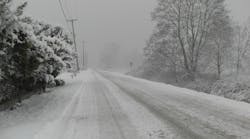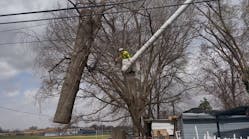In February 2021, I was traveling back to Dallas after visiting with a few employees in Houston. What is usually a six-hour drive was expected to be a 12-hour-or-so trip because of an incoming ice storm — one that would make history.
“This was one of the most impactful winter events in recent history that brought multiday road closures, power outages, loss of heat, broken pipes, and other societal impacts for the region,” according to the National Weather Service.
As the temperatures continued to drop and the ice began to cover the freeway, my slow creep of 30 m.p.h. quickly came to a halt. The freeway in Dallas-Fort Worth shut down and the only thing you could see for miles was a sea of taillights.
A similar previous 30-some-hour encounter of being stalled on the road lead me to be fully prepared for this situation where I had the essentials on hand. I was thankful to have an extra case of water in my truck, a working phone charger, a full tank of gas, and frequent communication between my family and peers.
After a night of sleeping (as much as I could) on the freeway and that long haul back to Midland made a lasting impression on me, and I was reminded that you can never be too prepared.
Prepare for the unexpected
Just as I experienced, you never know when you’ll encounter a cold weather-related emergency, especially when wintery conditions pop up seemingly out of nowhere. The National Weather Service suggests building an emergency supply kit for your vehicle that includes the following items.
- Cell phone charger
- First aid kit
- Jumper cables
- Spare tire
- Flares
- Full tank of gas
- Sand or kitty litter
- Tow rope
- Blankets
- Snow shovel and brush
- Flashlight
- Mittens, hats, boots, warm clothes, etc.
- Water and snacks
Preparation is key. Even if you’re in an area that isn’t typically prone to winter weather — like Texas — it is incredibly valuable to have a communication and disaster plan on hand ahead of time. It was comforting for family and teammates to be able to communicate back and forth while I was stuck on the freeway. They knew my whereabouts and frankly, that I was still alive.
In the case you find yourself stranded during a winter storm as I did, the American Red Cross offers a few tips.
- Stay in the vehicle and wait for help. Do not leave the vehicle to search for assistance unless help is visible within 100 yards. You can quickly become disoriented and confused in blowing snow.
- Display a trouble sign to indicate you need help. Hang a brightly colored cloth (preferably red) on the radio antenna and raise the hood after snow stops falling.
- Run the engine occasionally to keep warm. Turn on the engine for about 10 minutes each hour (or five minutes every half hour). Running the engine for only short periods reduces the risk of carbon monoxide poisoning and conserves fuel. Use the heater while the engine is running. Keep the exhaust pipe clear of snow, and slightly open a downwind window for ventilation.
- Leave the overhead light on when the engine is running so that you can be seen.
- Do light exercises to keep up circulation. Clap your hands and move your arms and legs occasionally. Try not to stay in one position for too long.
- If more than one person is in the vehicle, take turns sleeping. If you are not awakened periodically to increase body temperature and circulation, you can freeze to death.
- Huddle together for warmth. Use newspapers, maps, and even the removable floor mats for added insulation. Layering items will help trap more body heat.
- Watch for signs of frostbite and hypothermia. Severe cold can cause numbness, making you unaware of possible danger.
- Drink fluids to avoid dehydration, which can make you more susceptible to the ill effects of cold and heart attacks.
- Avoid overexertion. Cold weather puts an added strain on the heart. Shoveling snow or pushing a vehicle can bring on a heart attack or make other medical conditions worse.
Keep an Eye on the Sky (and Screens)
I can’t stress the importance of knowing your risk for inclement weather enough. The Federal Emergency Management Agency recommends paying attention to weather reports and warnings, listening for emergency information and alerts, and signing up for your community’s warning system.
As ACRT’s Storm Team manager, I may have a few more weather-related apps on my phone than most but I find value in having these resources on-hand — especially when stranded for 30-some hours due to cold weather.
If you’re a self-proclaimed weather junkie like me or want to feel better prepared, give these apps a try.
- Hurricane Tracker
- The Weather Channel
- Weather (standard iPhone weather app)
- FOX 4 WAPP
- Texas Storm Chasers
- MyRadar
It’s also helpful to follow your local utilities on social media, as they often post outage and safety alerts pertaining to their customers.
The moral of the story is, you can never be overprepared — whether it’s having an extra weather reporting tool on your device or stocking up your vehicle with the proper supplies. Take time this week to prepare your vehicle with an emergency supply kit, develop an emergency plan, and maybe even take a peek at the upcoming forecast.


